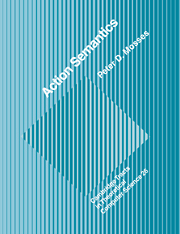Preface
Published online by Cambridge University Press: 19 January 2010
Summary
Formal semantics is a topic of major importance in the study of programming languages. Its applications include documenting language design, establishing standards for implementations, reasoning about programs, and generating compilers.
This book is about action semantics, a recently-developed framework for formal semantics. The primary aim of action semantics is to allow useful semantic descriptions of realistic programming languages.
Action semantics combines formality with many good pragmatic features. Regarding comprehensibility and accessibility, for instance, action semantic descriptions compete with informal language descriptions. Action semantic descriptions scale up smoothly from small example languages to full-blown practical languages. The addition of new constructs to a described language does not require reformulation of the already-given description. An action semantic description of one language can make widespread reuse of that of another, related language. All these pragmatic features are highly desirable. Action semantics is, however, the only semantic framework that enjoys them! (For syntax, context-free grammars have similar features, which perhaps accounts for their popularity in language reference manuals.)
Action semantics is compositional, like denotational semantics. The main difference between action semantics and denotational semantics concerns the universe of semantic entities: action semantics uses entities called actions, rather than the higher-order functions used with denotational semantics. Actions are inherently more operational than functions: when performed, actions process information gradually.
Primitive actions, and the various ways of combining actions, correspond to fundamental concepts of information processing. Action semantics provides a particular notation for expressing actions.
- Type
- Chapter
- Information
- Action Semantics , pp. xv - xxPublisher: Cambridge University PressPrint publication year: 1992
- 1
- Cited by

